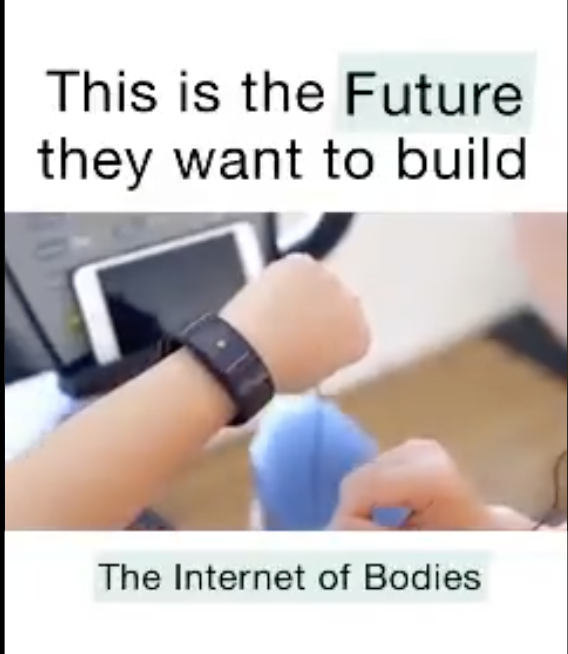The World Economic Forum (WEF) is attempting to normalize the idea of implanting tracking chips into humans, via the Internet of Bodies – a highly controversial technology.
The Internet of Bodies (IoB) is the biological extension of the Internet of Things (IoT) that brought us driverless cars and smart homes.
As part of the Great Reset, both are part of the plans for the future of humanity devised by the elites of the World Economic Forum. Truth Unmuted
🚨This is the most terrifying WEF prediction
— The Great Resist (@TheGreatRESlST) August 31, 2022
We have all heard about the WEFs anti-freedom agenda, but there is one scary prediction in it that stands out to me more than any other that isn't talked about enough.
Its called "The Internet of Bodies" or (IoB)
Let's investigate🧵
To save you having to go there, here’s what the WEF is cooking up now. By dressing it up as a necessary, even desirable, community building measure, they champion the use of monitoring and sharing health data. Of course, they insist, it won’t identify you. It’s to gather data to serve the greater good. Sure it is. Right up to that moment when you eat a doughnut too many and it reports you to your medical provider.
The internet of bodies pic.twitter.com/AIRt27BEWG
— Frank – Фрэнк 🚜🇳🇱💪🇨🇦🇷🇺 (@Francolinie) August 23, 2022
The Internet of Bodies is here. This is from the WEF website
- We’re entering the era of the “Internet of Bodies”: collecting our physical data via a range of devices that can be implanted, swallowed or worn.
- The result is a huge amount of health-related data that could improve human wellbeing around the world, and prove crucial in fighting the COVID-19 pandemic.
- But a number of risks and challenges must be addressed to realize the potential of this technology, from privacy issues to practical hurdles.
In the special wards of Shanghai’s Public Health Clinical Center, nurses use smart thermometers to check the temperatures of COVID-19 patients. Each person’s temperature is recorded with a sensor, reducing the risk of infection through contact, and the data is sent to an observation dashboard. An abnormal result triggers an alert to medical staff, who can then intervene promptly. The gathered data also allows medics to analyse trends over time.
The smart thermometers are designed by VivaLNK, a Silicon-Valley based startup, and are a powerful example of the many digital products and services that are revolutionizing healthcare. After the Internet of Things, which transformed the way we live, travel and work by connecting everyday objects to the Internet, it’s now time for the Internet of Bodies. This means collecting our physical data via devices that can be implanted, swallowed or simply worn, generating huge amounts of health-related information.
Some of these solutions, such as fitness trackers, are an extension of the Internet of Things. But because the Internet of Bodies centres on the human body and health, it also raises its own specific set of opportunities and challenges, from privacy issues to legal and ethical questions.

Connecting our bodies
As futuristic as the Internet of Bodies may seem, many people are already connected to it through wearable devices. The smartwatch segment alone has grown into a $13 billion market by 2018, and is projected to increase another 32% to $18 billion by 2021. Smart toothbrushes and even hairbrushes can also let people track patterns in their personal care and behaviour.
For health professionals, the Internet of Bodies opens the gate to a new era of effective monitoring and treatment.
In 2017, the U.S. Federal Drug Administration approved the first use of digital pills in the United States. Digital pills contain tiny, ingestible sensors, as well as medicine. Once swallowed, the sensor is activated in the patient’s stomach and transmits data to their smartphone or other devices.
In 2018, Kaiser Permanente, a healthcare provider in California, started a virtual rehab program for patients recovering from heart attacks. The patients shared their data with their care providers through a smartwatch, allowing for better monitoring and a closer, more continuous relationship between patient and doctor. Thanks to this innovation, the completion rate of the rehab program rose from less than 50% to 87%, accompanied by a fall in the readmission rate and programme cost.
The deluge of data collected through such technologies is advancing our understanding of how human behaviour, lifestyle and environmental conditions affect our health. It has also expanded the notion of healthcare beyond the hospital or surgery and into everyday life. This could prove crucial in fighting the coronavirus pandemic. Keeping track of symptoms could help us stop the spread of infection, and quickly detect new cases. Researchers are investigating whether data gathered from smartwatches and similar devices can be used as viral infection alerts by tracking the user’s heart rate and breathing.
At the same time, this complex and evolving technology raises new regulatory challenges.
